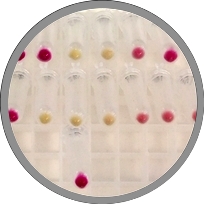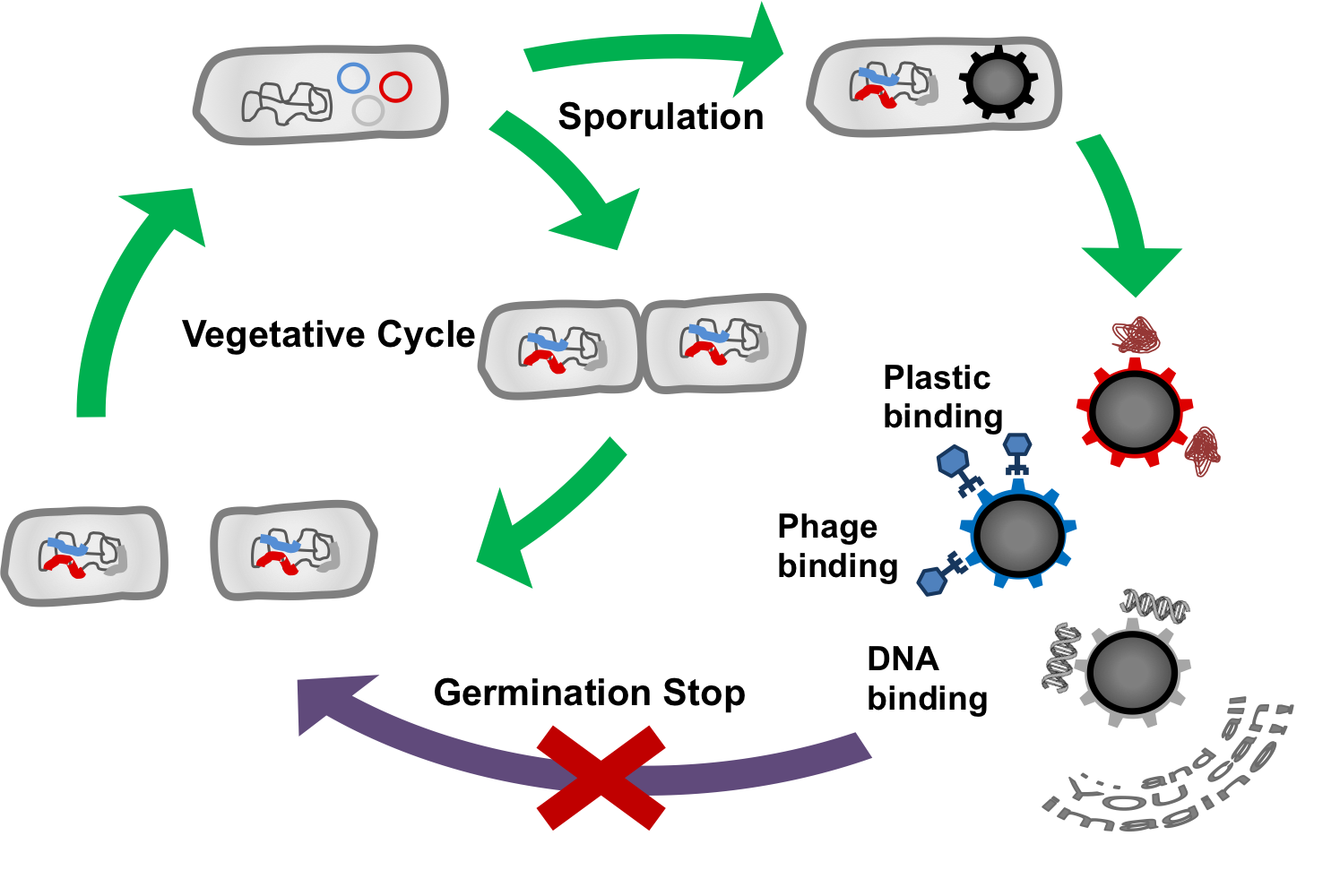|
|
| Line 18: |
Line 18: |
| | As a safety consideration, we will stop spores from germinating. First, we want to knock out several genes which are important for germination from the spore phase; second, we want potentially germinating spores to be killed by a toxin which they produce themselves. | | As a safety consideration, we will stop spores from germinating. First, we want to knock out several genes which are important for germination from the spore phase; second, we want potentially germinating spores to be killed by a toxin which they produce themselves. |
| | | | |
| - | == Project Details==
| |
| | | | |
| - | [[File:Project arrow 1.png|500px|center]]
| |
| | | | |
| | | | |
| | | | |
| - |
| |
| - | === Clone Vectors ===
| |
| - |
| |
| - | Part of establishing ''Bacillus subtilis'' to the BioBrick mode is to modify standard vectors of ''Bacillus''. We will mutate prohibited restriction sites (EcoRI, XbaI, SpeI, PstI) and excise redundant parts of the vectors.
| |
| - |
| |
| - | === Evaluate Promoters ===
| |
| - |
| |
| - | Another goal is to produce promoters of ''Bacillus subtilis'' in BioBrick mode and to evaluate them. These well-defined promoters will then be part of the ''Bacillus'' BioBrickBox which we will send to the registry but they can also be useful in our project '''Bead'''zillus to express our fusion crust proteins on the outside of our spores. Therefore we will use different promoters which are the constitutive promoters from the Anderson collection from the partsregistry, the constitutive promoters P<sub>''liaG''</sub>, P<sub>''veg''</sub> and P<sub>''lepA''</sub> from ''B. subtilis'' as well as the inducible promoter P<sub>''liaI''</sub> from ''B. subtilis''. For the characterization of the different promoters we will clone them upstream of reporter genes (lux operon, lacZ) to measure their activity in ''B. subtilis''. Therefore we use e.g. the two reporter vectors from ''B. subtilis'' which are also part of the ''Bacillus'' BioBrickBox. One of the reporter vectors pSB<sub>Bs</sub>3C-<i>luxABCDE</i> contains the ''lux'' operon as a reporter. This is why the activity of the promoter can be measured as luminescence with the plate reader (BioTek) which is a result of the expression of the luciferase. The second reporter vector used for the evaluation of the promoters is pSB<sub>Bs</sub>1C-''lacZ'' which contains the reporter gene ''lacZ''. The promoter activity leads to the production of the enzyme beta-galactosidase which cleaves the substrate ONPG. The product is detectable with the photometer and refers to the promoter activity.
| |
| - |
| |
| - |
| |
| - | === Fuse Spore Coat Proteins ===
| |
| - |
| |
| - | There are several different coat proteins in the spores of ''Bacillus subtilis.'' We chose CotZ and CgeA, which are located in the outermost layer of the spore coat. Our first step will be to fuse GFP to these proteins to see if they appear on the spore surface and if there is any effect on spore formation. The next step will be to fuse proteins with special features to CotZ and CgeA to produce functional "SporoBeads."
| |
| - | SporoBeads could be used to filter fluids or in the laboratory, and could be capable of:
| |
| - |
| |
| - | - binding harmful viruses
| |
| - |
| |
| - | - binding toxic metals
| |
| - |
| |
| - | - binding plastic molecules
| |
| - |
| |
| - | - exposing enzymes
| |
| - |
| |
| - | === Stop Germination ===
| |
| - |
| |
| - | To stop the SporoBeads from germinating, we have thought of two different manipulations. First, we will knock-out several genes which are necessary for all germination pathways, namely the cortex hydrolysis. Several gene deletion combinations will be tested for their outgrowth rates.
| |
| - |
| |
| - | As a second mechanism to prevent germination, spores which begin to germinate despite the gene deletions shall be killed by an endotoxin system. Here, we will work with a sigma-factor from a different species which works in ''Bacillus subtilis'' but does not interfere with endogenous promoters. This sigma factor is placed downstream of a promoter that is strongly activated by sigmaG, the last active sigma factor in the endospore. Therefore, the alternative sigma factor is produced right before sporulation. The bacteria also have a second construct inserted into their genome: a promoter activated by the alternative sigma factor which leads to the transcription of an endotoxin. So, if a spore starts metabolism, the toxin gene will be activated and kill the germinating spore.
| |
| - |
| |
| - | == Results ==
| |
| - |
| |
| - |
| |
| - | === Promoter Evaluation ===
| |
| - |
| |
| - | To get a set of promoters with different strength we chose several promoters. They can be divided in three different groups: the constitutive promoters from the [http://partsregistry.org/Part:BBa_J23100 Anderson collection] from the partsregistry, the constitutive promoters P''liaG'', P''veg'' and P''lepA'' from ''B. subtilis'' as well as the inducible promoter P''liaI'' from ''B. subtilis''. For the characterization of the different promoters they were all cloned upstream of reporter genes (lux operon, lacZ) to measure their activity in ''B. subtilis'' by regarding the gene expression of the reporter gene.
| |
| - |
| |
| - | ====Anderson promoters====
| |
| - |
| |
| - | The first group of promoters evaluated are the promoters of the Anderson collection which we call ''Anderson promoters''. They have already been measured in ''Escherichia coli'' and they all showed a constitutive behaviour but with a different strength. In this project, these Anderson promoters were measured in ''B. subtilis''. As they have already been evaluated in ''E. coli'', they were already in the partsregistry in the vector where they are fused to the ''Red fluorescent protein'' (RFP). For evaluation they were cut out of the vector and then first cloned in BioBrick standard in the empty vector pSB1C3 to send them to the registry. In addition, eleven (J23100,J23101, J23102, J23103, J23106, J23107, J23113, J23114, J23115, J23117, J23118) of the nineteen promoters of the Anderson collection were successfully cloned in the expression vector pSB<sub>Bs</sub>3C-<i>luxABCDE</i> from the BioBrickBox containing the ''lux'' operon as a reporter for promoter activity. The gene expression which correlates to the promoter activity leads to the expression of the ''lux'' operon with the luciferase. The luminescence which is produced by the luciferase can be measured with the plate reader (BioTek). To measure the activity not only with the lux reporter operon, four promoters were cloned into the reporter vector pSB<sub>Bs</sub>1C-''lacZ'' to do beta-galactosidase assays and then to compare the results of the strength of these promoters in ''B. subtilis''.
| |
| - |
| |
| - |
| |
| - | ====Constitutive promoters from ''B. subtilis''====
| |
| - |
| |
| - | The second group of promoters are constitutive promoters from ''B. subtilis''. We will evaluate the promoters P<sub>''liaG''</sub>, P<sub>''veg''</sub> and P<sub>''lepA''</sub>. Therefore we will use the reporter vectors pSB<sub>Bs</sub>3C-<i>luxABCDE</i> and pSB<sub>Bs</sub>1C-''lacZ'' to evaluate the promoters with different reporters, the ''lux'' operon and the ''lacZ'' gene. Therefore the promoters will be amplified from the genom of ''B. subtilis'' with primers that conatin the restriction sites of the BioBrick standard. Then these constitutive promoters will be cloned into the empty vector pSB1C3 to send them to the registry as well as the two reporter vectors to evaluate their strength in ''B. subtilis''.
| |
| - |
| |
| - | ====Inducible promoters from ''B. subtilis''====
| |
| - |
| |
| - | The last group of promoters consists of inducible promoters of ''B. subtilis'' e.g. P''<sub>liaI</sub>''. They are useful to decide when to turn on gene expression because these promoters need an inducer to start transcription. P''<sub>liaI</sub>'' can be induced by antibiotics which interact with the lipidII cycle, e.g. bacitracin. In this project this promoter is evaluated like the constitutive promoters with the reporter vector pSB<sub>Bs</sub>3C-<i>luxABCDE</i> which contains the ''lux'' operon as a reporter and with the vector pSB<sub>Bs</sub>1C-''lacZ'' which conatins the ''lacZ'' reporter gene. Therefore the promoters will be amplified from the genom of ''B. subtilis'' with primers that conatain the restriction sites of the BioBrick standard. Then these inducible promoters will be cloned into the empty vector pSB1C3 to send them to the registry as well as the two reporter vectors to evaluate their strength in ''B. subtilis''. To turn the promoter on we have to add an inducer.
| |
| | | | |
| | | | |





 "
"





